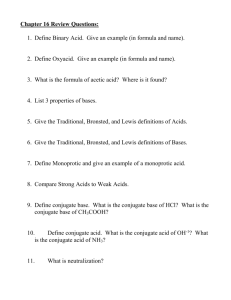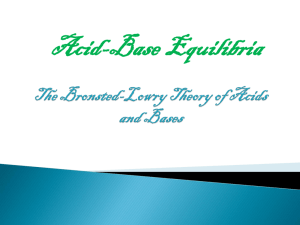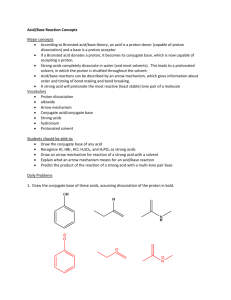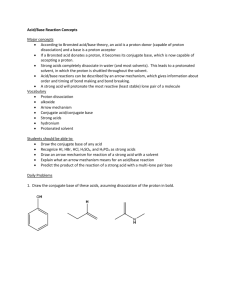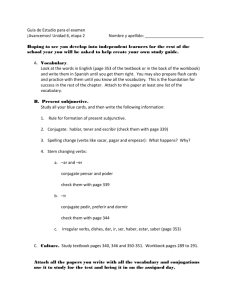Acids and Bases
advertisement
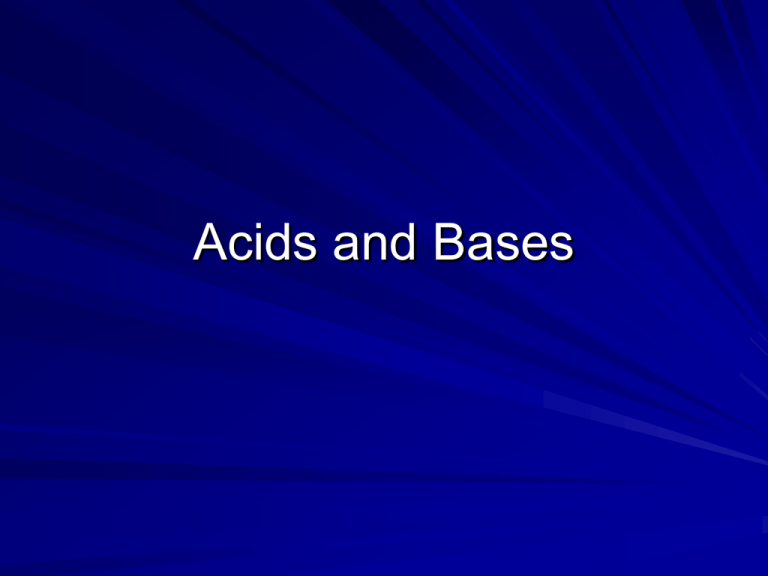
Acids and Bases Acids Definition : latin meaning sour “Acidus” Lots of acids – Dangerous Nitric Acid, Sulfuric Acid – Essential Ascorbic Acid – Dietary Acetic Acid (ethanoic acid) (vinegar), Citric Acid, Carbonic Acid – Odd Stearic Acid, Benzoic Acid info Turns blue Litmus paper Red React with metals to produce hydrogen gas H2SO4 + Zn ZnSO4 + H2 React with Carbonates to produce CO2 Arrhenius Theory An acid is a substance that dissociates in water to + produce H ions – Svante Arrhenius (nobel prize 1903) Add HCl to water and we get H+ ions and Chlorine Nitric and Sulfuric acid behave the same HCl H+ + Cl HNO3 H+ + NO3 H2SO4 2H+ + SO42- When we add a solution of Hydrogen chloride to water we call it Hydrochloric acid Mono basic: HCl H+ Di Basic H2SO4 2H+ + SO42- Tri Basic H3PO4 3H+ + PO43- + Cl Dependant on the number of hydrogen ions donated Strong and weak acids Sulfuric and nitric are strong as they dissociate fully in water but acetic acid is weak as it only partially dissociates Hydronium Ion The H+ ion ....just a proton Cannot exist independently in solution so the Hydronium ion is born The oxygen atom allows an electron to form a dative covalent bond with the hydrogen atom Hydrogen ion reacts with water to form Hydronium Ion H3O+ H. + H+ X H .O .. .O. X H HX + X H Hydronium Ion For accuracy we should use HA + H 2O H 3O + + A- HCl + H 2O H 3O + + Cl- Many chemists simply say the hydrogen ion Importance of water If we add pure Hydrogen Chloride or acetic acid into a solvent like benzene (no water) we do not get either H+ or Hydronium ion formation and blue litmus paper stays blue Shows that Hydrogen Chloride or acetic acid is only acid when water is present Bases Behave in the opposite manner to acids Turn Red litmus paper blue Example: – Sodium Hydroxide (NaOH) – Magnesium Hydroxide ([Mg(OH)2]) – Calcium Hydroxide ([Ca(OH)2]) Info Many bases have a soapy feel Used as degreasers in household detergents Act by converting the oil into soap which washes away more easily Arrhenius Theory A base is a substance that dissociates in water to produce OH- ions The OH- ion is called the hydroxide ion When added to water it dissociates completely into Sodium ions and hydroxide ions NaOH Na+ + OH- Arrhenius Theory Similarly for Magnesium Hydroxide and Calcium Hydroxide [Mg(OH)2] Mg2+ + 2OH- [Ca(OH)2] Ca2+ + 2OH- Strong and Weak bases Strong bases include Sodium Hydroxide because they dissociate almost completely in water but ....Magnesium Hydroxide and Calcium Hydroxide do not and are referred to as weak bases A number of flaws to the Arrhenius Theory Hydronium ions are present not bare hydrogen ions Arrhenius theory limited to aqueous solutions and not all acid base reactions are water based NH3 + HCl NH4Cl Base acid ammonium chloride Brønsted -Lowry Update needed to reflect more accurately the reactions that occur 1923 Johannes Bronsted (Danish) & Thomas Lowry (English) – working independently came up with the same theory Brønsted -Lowry Definition of an Acid –An acid is a proton donor Definition of a base –A Base is a proton acceptor Detail HCl + H2O Acid Donates base accepts a proton a proton H3O + + Cl- Therefore these obey the B/L definition Ammonia Gas NH3 + H2O base accepts acid Donates a proton a proton NH4 + + OH- Therefore these obey the B/L definition What to learn Water can act as an acid or a base amphoteric Can be applied to non aqueous reactions HCl Acid + NH3 base NH4+ + Cl- Brønsted –Lowry broadens the definition of what can act as an acid or a base Homework Questions 12.1 in textbook and 12.1 in workbook Conjugate acid-base pairs Add acetic acid (ethanoic acid) to water CH3COOH H3O + H 2O CH3COO- + The reaction works in both directions Conjugate acid-base pairs Add acetic acid (ethanoic acid) to water CH3COOH + H 2O H3O Donates accepts A proton a proton CH3COO- + Conjugate acid-base pairs Add acetic acid (ethanoic acid) to water CH3COO- + H3O H2O Accepts Donates A proton a proton CH3COOH The water is behaving like an acid + Conjugate acid-base pairs Add acetic acid (ethanoic acid) to water CH3COOH H3O + H 2O CH3COO- + The reaction works in both directions so we call each conjugate pairs CH3COOH is a conjugate acid of CH3COO- CH3COO- is a conjugate base of CH3COOH An acid changes into a conjugate base when it donates a proton CH3COOH CH3COOH+ acid Conjugate proton base A base changes into a conjugate acid when it accepts a proton CH3COO- H+ CH3COOH base proton conjugate acid Every acid has a conjugate base and every base has a conjugate acid... We call this an conjugate acid - base pair A conjugate acid – base pair is any pair consisting of an acid and a base which differs by one proton Important The definition says that the pair must involve a single proton so...the conjugate pair of H2SO4 HSO4 Example What is the conjugate acid and the conjugate base of HC2O4To change into its conjugate the base must accept a proton...so HC2O4base + H+ H 2C 2O 4 conjugate acid Example What is the conjugate acid and the conjugate base of HC2O4To change into its conjugate the acid must donate a proton...so HC2O4Acid C 2O 4 2 - + H+ conjugate base Tell me Which is the acid and which is the base HNO3 + H2F2 Also mark out the pairs H2NO3 + HF2 HNO3 Base + H2F2 Acid H2NO3 + Acid Conjugate acid-base pair Conjugate acid-base pair HF2 Base Neutralisation Neutralisation is the reaction between an acid and a base to form salt and water Neutralisation Acids and base in the correct proportions cancel each other out This means they lose their characterisitics,the acid is no longer behaving like and acid and vice versa The resulting solution has a neutral effect on litmus paper example HCl + NaOH NaCl+ H2O The word salt simply refers to the fact that the hydrogen in the acid is replaced by a metal or ammonium ion What’s Happening? HCl + NaOH NaCl+ H2O In soln: H+ + Cl - + Na + + OH - = H O 2 Lets ignore the spectator ions Na + + Cl H+ + Cl - + Na + + OH - = H O 2 Na + + Cl The hydrogen (hydronium) ions from the acid are reacting with the hydroxide ions from the base to form water which results in a neutral solution Everyday examples Stomach HCL neutralised by NaHCO3 – In other words...by an antacid (bioSodol) containing sodium hydrogencarbonate HCl + NaHCO3 CO2 Another example (Maalox) 2HCl + Mg(OH)2 NaCl + H2O + MgCl + H2O Everyday examples Calcium Oxide (lime) spread on soil to neutralize the acid conditions CaO + H2O Lime + water Ca(OH)2 Calcium Hydroxide Calcium Hydroxide can neutralize acidity as follows Ca(OH)2 + H2SO4 2H2O CaSO4 + Calcium hydroxide plus Sulfuric Acid becomes Calcium Sulfate and Everyday examples Limestone added to lake water to neuralise the effects of acid rain CaCO3 + H2SO4 2H2O + CO2 CaSO4 + Calcium carbonate plus Sulfuric Acid becomes Calcium Sulfate and Water and Carbon Dioxide Homework Questions 12.2 – 12.6 in textbook and 12.2 – 12.4 in workbook

